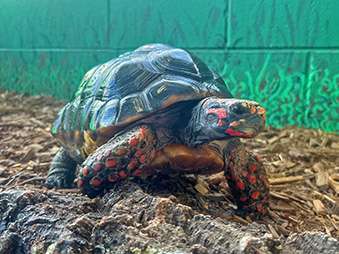Chelonoidis carbonaria | Red-footed Tortoise
Names:
- Male: Boxer
- Female: Marcella, Otis



Meet Boxer, Marcella, and Otis our Red-footed Tortoise
With their striking red and orange markings and peaceful demeanor, Red-footed tortoises are colorful residents of the rainforests and grasslands of South and Central America. Native to countries such as Brazil, Paraguay, and Colombia, these slow-moving reptiles are like nature’s walking artwork. Despite their unhurried pace, they’re full of personality and curiosity, making them a delight to observe in the wild or at the zoo.
Laid-Back Lifestyle
Red-footed tortoises are terrestrial animals that thrive in warm, humid environments. Known for their calm and easygoing nature, they often coexist peacefully with other species—both in the wild and in zoo habitats. At the zoo, they share their space with Ramon and Pax, our cotton-top tamarins and Elton, the Hoffman’s two-toed sloth, all of whom originate from similar tropical regions.
Their omnivorous diet is just as varied as their habitat. In the wild, they forage for fruits, vegetables, flowers, and occasionally invertebrates and carrion-animals that have already passed away. This adaptability helps them succeed in changing seasonal conditions. At the zoo, they enjoy a well-balanced menu that includes Mazuri® Tortoise Diet, timothy hay and hay pellets, greens, fruits, vegetables, and sepia bone, ensuring they stay healthy and well-fed.
Striking Yet Subtle
These tortoises are easily identified by their dark shells, typically black or deep brown, with lighter, yellowish centers on each scute that mimic the sun shining through to the forest floor. Bright red or orange scales on their limbs and faces add to their distinctive appearance. While their coloration stands out to us, it provides effective camouflage for life on the forest floor.
Red-footed tortoises are naturally solitary, but they tend to tolerate the presence of others in safe, enriched environments. Their gentle nature and unique look make them popular among zoo guests.
Chicken or Tortoise?
Red-footed tortoises are polygynous, meaning a single male may mate with multiple females. During mating season, males try to attract females by making clucking sounds—described as similar to a chicken’s call. They also compete with other males by bobbing their heads and attempting to flip rivals onto their backs.
Both males and females reach sexual maturity around five years of age. Between June and September, females may lay several clutches per season, each containing anywhere from 2 to 15 eggs. To lay her eggs, a female digs a hole about 20 cm deep, deposits the eggs, then covers them with soil and leaf litter. Once the hatchlings emerge, they dig themselves out and begin life entirely on their own—there is no parental care.
Caution before purchasing
As wonderful as these tortoises are to observe, red-footed tortoises are not suitable pets for most people. They require large enclosures, specialized heating and lighting, a carefully controlled diet with supplements, and access to veterinary care from reptile specialists.
Sadly, many tortoises—like Boxer, Marcella, and Otis—end up in rescues when people realize too late how demanding their care can be. For this reason, it’s best to enjoy these amazing reptiles in zoos or through educational programs. To learn more about why reptiles aren’t good pets for the average person, visit the Not-a-Pet campaign!
Fact Sheet
Taxonomy
Species: Chelonoidis carbonaria
Kingdom: Animalia | Phylum: Chordata | Class: Reptilia | Order: Testudines | Family: Testudinidae | Genus: Chelonoidis |
Favorite Enrichment Type
Brush heads, ball pit balls, hiding opportunities!
What We Sound Like
Life Span
- In the Wild: Believed to live from 20 to 40 years, more research is needed.
- In Human Care: 40+ years
Diet
- In the Wild: They eat a wide variety of both plant and animal materials. Depending on the season and food availability, their diet will change.
- At the Zoo: Mazuri® Tortoise Diet, timothy hay and hay pellets, greens, fruits, vegetables, and sepia bone.
Geographic Range
Found in many locations in Central and South America, as well as the island of Trinidad in the Caribbean.
Habitat
They can be found in dry thorny and temperate forests, as well as rainforests and savannas. They have a preference to heavily forested, humid areas with not a lot of mud.
Fun Facts
- Colorful Creatures: Their red and orange limbs and patterned shells make them easy to recognize—and easy to love.
- Omnivorous Eaters: They enjoy a mixed diet of fruits, greens, flowers, and sometimes invertebrates.
- Rainforest Residents: They live in tropical regions of South America, foraging on the forest floor.
- Peaceful Companions: Their mellow attitude allows them to share space with other animals in both the wild and zoos.
Status: Not Evaluated
Conservation
Although the Red-Footed Tortoise has not yet been evaluated by the IUCN (International Union for Conservation of Nature), they face threats similar to other rainforest species like Hoffman’s two-toed sloths and cotton-top tamarins. Habitat destruction and hunting—often for food—continue to impact their populations in the wild.
By learning about these incredible creatures and supporting conservation efforts, we can help protect them and their rainforest ecosystems for generations to come.
How to Find Us
In the Rainforest Building along with Elton the two-toed sloth, and Ramon and Pax, our cotton-topped tamarins, down the path from the Contact Yard and across from the chicken coop area.
